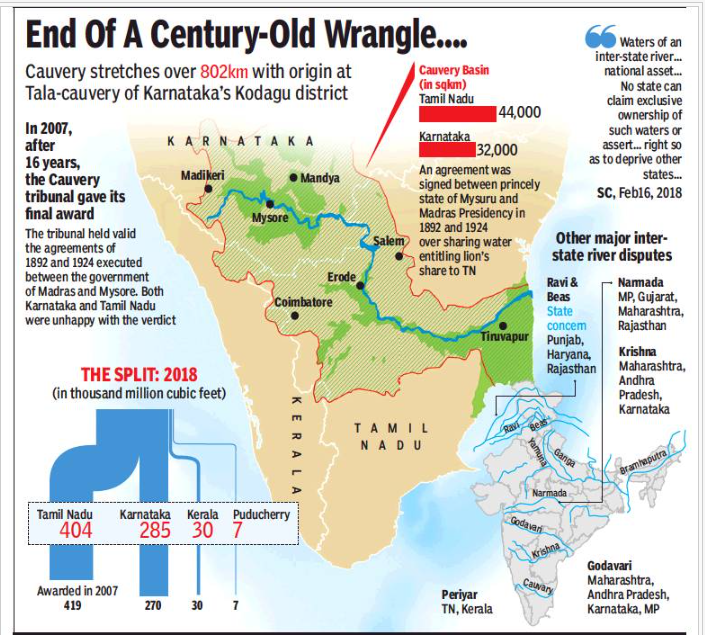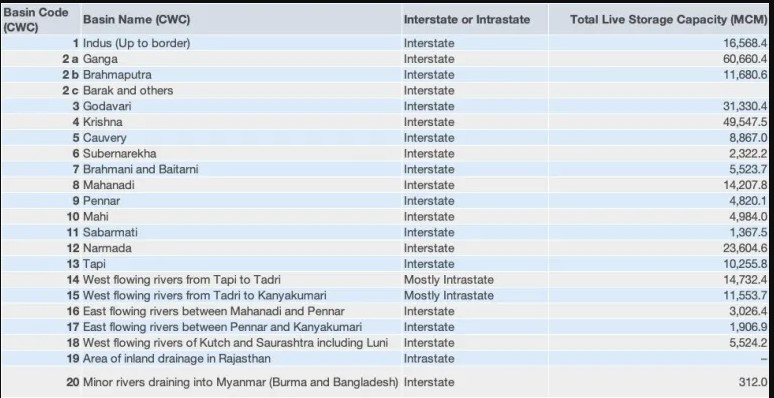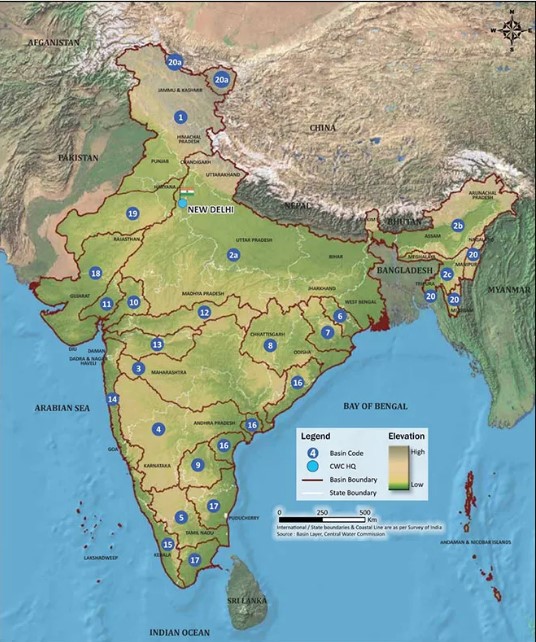ForumIAS announcing GS Foundation Program for UPSC CSE 2025-26 from 19 April. Click Here for more information.
Contents
- 1 What is Cauvery Water Dispute and its reasons?
- 2 Reasons for Cauvery Water Dispute
- 3 What are the other Interstate river disputes apart from the Cauvery water Dispute?
- 4 Constitutional Arrangements to solve Interstate Water Disputes
- 5 Statutory Arrangements to solve Interstate Water Disputes
- 6 What are the reasons for persistence of Inter-State Water Disputes ?
- 7 What Should be the way forward in resolving these Disputes?
| For 7PM Editorial Archives click HERE → |
Cauvery Water Dispute is in news again and has strained the relations between Karnataka and Tamil Nadu government. The Supreme Court declined to interfere with the order of the Cauvery Water Management Authority (CWMA) which directed Karnataka to release 5,000 cubic feet of water per second (cusecs) to Tamil Nadu until September 27, 2023. This sparked off massive protests in Karnataka. Karnataka is protesting that it will experience water scarcity as it has been a monsoon deficient season.
Read More- Cauvery Water Management Authority (CWMA)
What is Cauvery Water Dispute and its reasons?
The Cauvery water dispute is an inter-state water dispute between Tamil Nadu, Karnataka, Kerala and Puducherry.

Historical Timeline of Cauvery River Water Dispute | |
| 1892 | This dispute originated for the first time way back in 1892 at the time of Britishers between the Presidency of Madras and Princely state of Mysore. |
| 1924 | In 1924 Mysore and Madras reached into an agreement which will be valid for 50 years. Hence, it ceased to be enforced in 1974. |
| 1974 | Since 1974, Karnataka started diverting water into its four newly made reservoirs, without the consent of Tamil Nadu.This resulted in dispute in post independent India. |
| 1990 | After several years, the Cauvery Water Disputes Tribunal (CWDT) was established in 1990 to resolve the issue. It took 17 years for the CWDT to reach a final order in 2007. |
| 2007 | CWDT issued its final award in February 2007 and specified water allocations among the four states in the Cauvery basin, considering the total availability of 740 TMC in a normal year.The allocation of water among the four states is as follows: Tamil Nadu – 419 TMC(which had demanded 512 TMC), Karnataka – 270 TMC(which had demanded 465 TMC), Kerala – 30 TMC and Puducherry – 7 TMC. |
| 2018 | In 2018, the Supreme Court declared the Cauvery a national asset and largely upheld the water-sharing arrangements determined by the CWDT. It made minor readjustments in the CWDT order. As per the judgement, Tamil Nadu – 404.25 TMC, Karnataka- 284.75 TMC, Kerala 30 TMC and Puducherry 7 TMC. It also directed the Centre to notify the Cauvery Management Scheme. Central government notified the ‘Cauvery Water Management Scheme’ in June 2018, constituting the ‘Cauvery Water Management Authority’ and the ‘Cauvery Water Regulation Committee’. |
Even though the Water Sharing mechanism has been put in place by the Cauvery Water Disputes Tribunal (CWDT) and the subsequent SC judgement in 2018, there has been regular disputes in the water sharing arrangement.
Reasons for Cauvery Water Dispute
1. Deficit monsoon and unavailability of water – Poor inflow due to reduced rainfall in Cauvery catchment, including origin point, Kodagu. Karnataka highlights a 44% rainfall deficit in Kodagu from June to August.
2. Water Scarcity In Tamil Nadu- Tamil Nadu’s Mettur reservoir holds only 20 TMC, which will last ten days.
3. Disagreement over the water sharing agreement as per CWMA- Both Karnataka and Tamil Nadu disagree with the water sharing agreement of Cauvery Water Management Authority (CWMA).
4. Hydropolitics and Delays – Political parties capitalise on water disputes for mobilisation. Prolonged tribunal adjudications have also contributed to delays.
What are the other Interstate river disputes apart from the Cauvery water Dispute?
The following map and the corresponding table shows the various Interstate river disputes that have been prevailing in India.

Constitutional Arrangements to solve Interstate Water Disputes
| Schedule 7 of the Constitution | It distinguishes between the use of water within a State and the purpose of regulating interstate waters. Union List- Entry 56 gives the Union Parliament the power to formulate laws and mechanisms for regulating Interstate rivers. State List – Entry 17 gives States retain autonomy regarding water utilisation for purposes such as water supply, irrigation and canals, drainage and embankments, water storage and water power subject to provisions of Entry 56 of List 1 (Union List). |
| Article 262 | In case of disputes relating to waters, Parliament may by law provide for the adjudication of any dispute or complaint with respect to the use, distribution or control of the waters of, or in, any inter-State rivers. Parliament may, by law also provide that neither the Supreme Court nor any other court shall exercise jurisdiction in respect of any such dispute or complaint as mentioned |
Statutory Arrangements to solve Interstate Water Disputes
| River Board Act 1956 | The river Boards are supposed to advise on the Inter-state basin to prepare development scheme and to prevent the emergence of conflicts. |
| Inter-State Water Dispute Act 1956 | If a particular State or States approach the Union Government for the constitution of the tribunal: (a) Central Government should try to resolve the matter by consultation among the aggrieved States; (b) In case, consultation does not work, then the Union Government may constitute the tribunal. |
What are the reasons for persistence of Inter-State Water Disputes ?
In India, Inter-state river disputes like Cauvery water disputes have persisted due to the following reasons, which are enumerated below-
Unbalanced distribution of powers between Union and state governments- The legislative powers concerning water have been distributed between the Union and the State Governments. However, this approach of imprecise distribution of power between the Union and the States, has created a Federal-Jurisdictional ambiguity.
Limited powers of River Tribunals – The Tribunal can only make an award and cannot make it binding. The Tribunals also lack the ability to punish for ‘contempt’.
Institutional ambiguity in adjudication of river water disputes – Article 262 provides that the Parliament may by law prevent the Supreme Court or any other Court from exercising jurisdiction in inter-State water disputes. However, under Article 136, the Supreme Court can hear appeals against the orders of Tribunals. Thus, the Supreme Court remains the adjudicatory body along with the tribunals, creating an institutional ambiguity regarding which body is the ultimate adjudicatory power on inter-State water disputes in India.
Lack of technical expertise in the tribunals members – The members of tribunals created for adjudicating the inter-State water disputes have been predominantly from the Judiciary. This has lead to lack of a multi-disciplinary approach to dispute settlement.
Excessive delays in establishing tribunals and making awards- The right to have a dispute referred to a tribunal under the IWSDA (Inter-State Water Dispute Act) is contingent on the Union Government’s determination that the matter cannot be resolved through negotiations. The provision of negotiations inevitably delays the constitution of a tribunal.
Political Mobilisation and electoral benefits- Inter-State disputes are exploited for political mobilization and electoral benefits. State Governments have rejected the awards of Tribunals for political gains.
Unscientific water data management – There is a lack of data regarding water flows, seasonal variations etc. which results in ambiguities regarding availability of water, surplus water for sharing etc. In addition, seasonal variations in monsoonal rainfall sometimes create shortage of water.
What Should be the way forward in resolving these Disputes?
These interstate river disputes and the cauvery water disputes must be resolved in the following ways to reach amicable solutions at the earliest.
Provide mutually accepted water sharing/ deficit formula- Cauvery Water Management Authority (CWMA) should find a mutually accepted water sharing/ deficit formula. Water Allocation should be based on the basis of monsoon and availability of water
Transparency in the proceedings of CWRC- The CWMA and Cauvery Water Regulation Committee (CWRC) should publish their meeting proceedings online.
Rejuvenation of Inter state Councils – Article 263 of the Indian Constitution provides for the establishment of Interstate council to resolve interstate differences. Inter-State Council should be rejuvenated to enable it to play a more active role in settlement of interstate river disputes. To solve interstate water disputes, economic survey has suggested for cooperative federalism just like GST.
Fixed time frame for adjudication- There is a need to establish a time frame for constituting the Tribunal by the Union Government. Tribunals should also try to avoid unnecessary delays in giving the award.
Simplification of Judicial process of dispute resolution – The Government’s inability to properly handle water-related disputes is reflected in the high number of appeals to the Supreme Court. Some experts suggest that the appeal to the Supreme Court should only on procedural aspects. The awards based on expert opinions shouldn’t be questioned in the Court. The Sarkaria Commission has suggested that the awards of the tribunals be given the same weight as a Supreme Court Judgement.
Exploration of Mediation route to solve the inter state river disputes – Mediation can also be explored as a possible option for successful resolution of disputes. The example of the role of the World Bank as a mediator in the Indus Water Treaty between India and Pakistan is quoted as a success of this model.
Better water data management- Infrastructure should be created for better collection of the data related to inter-State river basins. Better data will provide clear picture regarding availability of waters, seasonal variations and help in the equitable distribution of water among the States.
Read More- Cauvery water Dispute The Hindu





